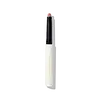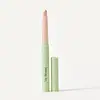What's inside
What's inside
 Key Ingredients
Key Ingredients

 Benefits
Benefits

 Concerns
Concerns

 Ingredients Side-by-side
Ingredients Side-by-side

Octyldodecanol
EmollientMica
Cosmetic ColorantTridecyl Trimellitate
EmollientRicinus Communis Seed Oil
MaskingHelianthus Annuus Seed Wax
Skin ConditioningHydrogenated Vegetable Oil
EmollientTribehenin
EmollientButyrospermum Parkii Butter
Skin ConditioningNymphaea Caerulea Flower Extract
Skin ConditioningJojoba Esters
EmollientSilica
AbrasiveSqualane
EmollientCaprylic/Capric Triglyceride
MaskingDimethyl Isosorbide
SolventOleic/Linoleic/Linolenic Polyglycerides
EmollientTocopheryl Acetate
AntioxidantSesamum Indicum Seed Extract
Skin ConditioningTocopherol
AntioxidantIron Oxides
CI 15850
Cosmetic ColorantCI 77891
Cosmetic ColorantOctyldodecanol, Mica, Tridecyl Trimellitate, Ricinus Communis Seed Oil, Helianthus Annuus Seed Wax, Hydrogenated Vegetable Oil, Tribehenin, Butyrospermum Parkii Butter, Nymphaea Caerulea Flower Extract, Jojoba Esters, Silica, Squalane, Caprylic/Capric Triglyceride, Dimethyl Isosorbide, Oleic/Linoleic/Linolenic Polyglycerides, Tocopheryl Acetate, Sesamum Indicum Seed Extract, Tocopherol, Iron Oxides, CI 15850, CI 77891
Cyclopentasiloxane
EmollientTrimethylsiloxysilicate
EmollientLauroyl Lysine
Skin ConditioningPolyethylene
AbrasiveOctyldodecanol
EmollientOzokerite
Emulsion StabilisingBeeswax
Emulsion StabilisingParaffin
PerfumingSilicon
AbrasiveStearyl Stearate
EmollientStearyl Palmitate
EmulsifyingCetyl Palmitate
EmollientLecithin
EmollientEthyl Stearate
EmollientDisteardimonium Hectorite
StabilisingArachidic Acid
CleansingStearic Acid
CleansingTocopherol
AntioxidantDicalcium Phosphate
AbrasivePropylene Carbonate
SolventAscorbyl Palmitate
AntioxidantCalcium Sodium Borosilicate
Palmitic Acid
EmollientCitric Acid
BufferingCalcium Aluminum Borosilicate
Synthetic Fluorphlogopite
PEG-8 Caprate
EmulsifyingPolyurethane-33
Mica
Cosmetic ColorantCI 15850
Cosmetic ColorantCI 19140
Cosmetic ColorantCI 77000
Cosmetic ColorantCI 77491
Cosmetic ColorantTitanium Dioxide
Cosmetic ColorantCyclopentasiloxane, Trimethylsiloxysilicate, Lauroyl Lysine, Polyethylene, Octyldodecanol, Ozokerite, Beeswax, Paraffin, Silicon, Stearyl Stearate, Stearyl Palmitate, Cetyl Palmitate, Lecithin, Ethyl Stearate, Disteardimonium Hectorite, Arachidic Acid, Stearic Acid, Tocopherol, Dicalcium Phosphate, Propylene Carbonate, Ascorbyl Palmitate, Calcium Sodium Borosilicate, Palmitic Acid, Citric Acid, Calcium Aluminum Borosilicate, Synthetic Fluorphlogopite, PEG-8 Caprate, Polyurethane-33, Mica, CI 15850, CI 19140, CI 77000, CI 77491, Titanium Dioxide
 Reviews
Reviews

Alternatives
Ingredients Explained
These ingredients are found in both products.
Ingredients higher up in an ingredient list are typically present in a larger amount.
Ci 15850 is the pigment color red. It is an azo dye and created synthetically.
Azo dyes need to be thoroughly purified before use. This allows them to be more stable and longer-lasting.
This ingredient is common in foundations, lipsticks, and blushes. This color is described as brown/orangey red.
It has many secondary names such as Red 6 and Red 7. According to a manufacturer, Red 6 usually contains aluminum.
Learn more about CI 15850Mica is a naturally occurring mineral used to add shimmer and color in cosmetics. It can also help improve the texture of a product or give it an opaque, white/silver color.
Serecite is the name for very fine but ragged grains of mica.
This ingredient is often coated with metal oxides like titanium dioxide. Trace amounts of heavy metals may be found in mica, but these metals are not harmful in our personal products.
Mica has been used since prehistoric times throughout the world. Ancient Egyptian, Indian, Greek, Roman, Aztec, and Chinese civilizations have used mica.
Learn more about MicaOctyldodecanol is a fatty alcohol. It is primarily used to enhance the texture of products.
As an emulsifier, Octyldodecanol helps prevent the oils and waters from separating. It also prevents ingredients from creating foam when shaken.
Octyldodecanol is created by reducing fatty acid to an alcohol.
Due to its high molecular weight, it does not get absorbed into the skin.
Learn more about OctyldodecanolTocopherol (also known as Vitamin E) is a common antioxidant used to help protect the skin from free-radicals and strengthen the skin barrier. It's also fat soluble - this means our skin is great at absorbing it.
Vitamin E also helps keep your natural skin lipids healthy. Your lipid skin barrier naturally consists of lipids, ceramides, and fatty acids. Vitamin E offers extra protection for your skin’s lipid barrier, keeping your skin healthy and nourished.
Another benefit is a bit of UV protection. Vitamin E helps reduce the damage caused by UVB rays. (It should not replace your sunscreen). Combining it with Vitamin C can decrease sunburned cells and hyperpigmentation after UV exposure.
You might have noticed Vitamin E + C often paired together. This is because it is great at stabilizing Vitamin C. Using the two together helps increase the effectiveness of both ingredients.
There are often claims that Vitamin E can reduce/prevent scarring, but these claims haven't been confirmed by scientific research.
Learn more about Tocopherol